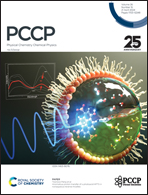A reinvestigation of the boron cluster B15+/0/−: a benchmark of density functionals and consideration of aromaticity models†
Abstract
This study presents a thorough reinvestigation of the B15+/0/− isomers, first employing coupled-cluster theory CCSD(T) calculations to validate the performance of different DFT functionals. The B15+ cation has two planar lowest-lying isomers, while the first 3D isomer is less stable than the global minimum by ∼10 kcal mol−1. The PBE functional, within this benchmark survey, has proved to be reliable in predicting relative energies for boron isomers. Other functionals such as the TPSSh, PBE0 and HSE06 result in good energy ordering of isomers but warrant reconsideration when distinguishing between 2D and 3D forms. Caution is needed for structures having high spin contamination, as it may lead to significant errors. The anomalously lower stability of the B15− anion with respect to its neighbours, in terms of electron detachment energy, was explained through a competition between both rectangle and disk models for its geometry. This elucidates its stability with 12 electrons in rectangle model and instability with 10 electrons in disk-shaped structure, emphasizing the value of employing such geometric models. The proximity of the σ* LUMO to the π HOMO also contributes to the weakening of the B15− stability.

- This article is part of the themed collection: 2024 PCCP HOT Articles


 Please wait while we load your content...
Please wait while we load your content...